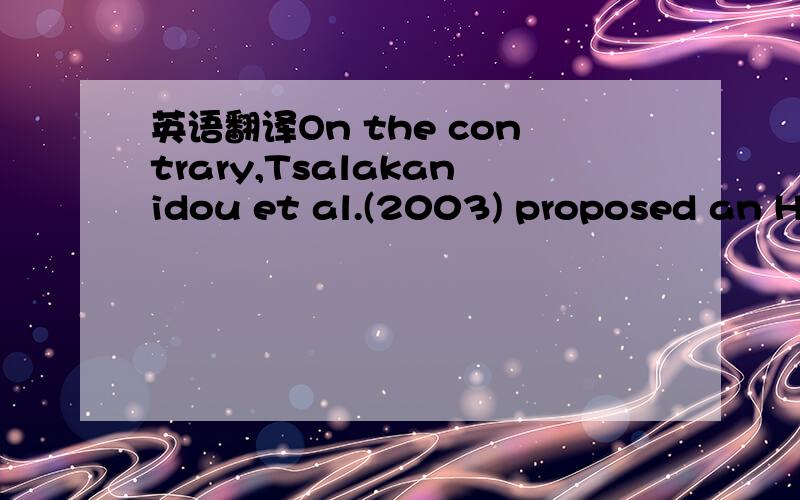英语翻译On the contrary,Tsalakanidou et al.(2003) proposed an HM
来源:学生作业帮 编辑:大师作文网作业帮 分类:综合作业 时间:2024/11/11 13:08:25
英语翻译
On the contrary,Tsalakanidou et al.(2003) proposed an HMM approach to integrate depth data and intensity image.The method start localizing the face with a depth and brightness based procedure,while the recognition task exploits the embedded hidden Markov model technique
that is applied to 3D range images as well as 2D images.The experimental results are gathered on a very large data-base of 3000 range and greyscale images of 50 subjects,with various facial expressions,poses,illuminations and with/without glasses,reporting a recognition rate of 90.7% on 2D intensity images and 80% on 3D range images,while the system reaches a rate of 91.67%,when both information are combined.Papatheodorou and Rueckert (2004) proposed a 4D registration method based on Iterative Closest Point (ICP),but adding textural information too.The data acquisition is done with a stereo camera system composed by three cameras and a pattern projector,while the measurement of facial similarity involves a 4D Euclidean distance (represented by colors 1 as shown in Fig.13) between four-dimensional points:the three spatial coordinates more the texel intensity information.They report various results on a dataset collected from 62 subjects with 13 distinct 3D meshes and 2D texture maps considering several facial expression and poses.The percentage of correct matches and correct rejection are used as performance measures.In case of frontal pose,results show that the use of both texture and shape improves performances,while a percentage of correct recognition ranging from 66.5% to 100%,depending on several poses and expressions.
Therefore,the current state of the art makes clear that,by themselves,none of the existing techniques is able to cope with all kind of distortions that a face can undergo,suggesting that only a proper combination of the current methods can be robust enough to be applied in a real-world scenario.Three main types of multimodal systems can be conjectured,depending on the involved biometrics.The lowest level of multimodality is represented by a system integrating several 2D image based face recognition sub-systems.The real advantage of this system is that all the strengths of the face biometric even hold,making it also suitable in case of outdoor conditions.However setting up this framework presents two great difficulties.First of all,the way to assess what kind of distortions a face present,in order to select a correct class of sub-systems to process the input.Secondly,if more sub-systems have been activated,it is very difficult to state which fusion strategy provides better performances,in terms of global system response.
不要机器翻的,务必通顺,谢咯!
On the contrary,Tsalakanidou et al.(2003) proposed an HMM approach to integrate depth data and intensity image.The method start localizing the face with a depth and brightness based procedure,while the recognition task exploits the embedded hidden Markov model technique
that is applied to 3D range images as well as 2D images.The experimental results are gathered on a very large data-base of 3000 range and greyscale images of 50 subjects,with various facial expressions,poses,illuminations and with/without glasses,reporting a recognition rate of 90.7% on 2D intensity images and 80% on 3D range images,while the system reaches a rate of 91.67%,when both information are combined.Papatheodorou and Rueckert (2004) proposed a 4D registration method based on Iterative Closest Point (ICP),but adding textural information too.The data acquisition is done with a stereo camera system composed by three cameras and a pattern projector,while the measurement of facial similarity involves a 4D Euclidean distance (represented by colors 1 as shown in Fig.13) between four-dimensional points:the three spatial coordinates more the texel intensity information.They report various results on a dataset collected from 62 subjects with 13 distinct 3D meshes and 2D texture maps considering several facial expression and poses.The percentage of correct matches and correct rejection are used as performance measures.In case of frontal pose,results show that the use of both texture and shape improves performances,while a percentage of correct recognition ranging from 66.5% to 100%,depending on several poses and expressions.
Therefore,the current state of the art makes clear that,by themselves,none of the existing techniques is able to cope with all kind of distortions that a face can undergo,suggesting that only a proper combination of the current methods can be robust enough to be applied in a real-world scenario.Three main types of multimodal systems can be conjectured,depending on the involved biometrics.The lowest level of multimodality is represented by a system integrating several 2D image based face recognition sub-systems.The real advantage of this system is that all the strengths of the face biometric even hold,making it also suitable in case of outdoor conditions.However setting up this framework presents two great difficulties.First of all,the way to assess what kind of distortions a face present,in order to select a correct class of sub-systems to process the input.Secondly,if more sub-systems have been activated,it is very difficult to state which fusion strategy provides better performances,in terms of global system response.
不要机器翻的,务必通顺,谢咯!

相反,Tsalakanidou等.(2003)提出一个HMM做法,把深度数据和强度的形象.这个方法的脸开始本地化流程、深度和亮度的识别利用嵌入式隐马尔可夫模型的技术
这是应用于三维图像以及范围二维images.The实验结果都聚集在一个非常大的范围和数据库的灰度图像的3000名受试者,50岁的面部表情、姿势、灯饰、/不戴眼镜的话,报告上的二维识别率90.7% 3D图象和80%强度范围,达到了系统的信息是在例行的总和.Papatheodorou和Rueckert(2004)模型,提出了一种基于迭代方法4D登记最近点(ICP),但是添加纹理信息.数据采集是做了一个立体摄像系统由三台照相机和模式,同时测量的投影机面部相似性涉及到欧氏距离(代表4D颜色1如图13)之间的四维分.三次空间坐标更多纹理强度的信息.他们报告结果显示,不同数据来自62个科目的三维网格和二维13个不同质地地图考虑几个面部表情和动作.正确的匹配的比例和正确使用性能的措施为拒绝.万一额的姿势,结果表明,用两种贴图和形状改进性能,同时一定比例的正确认识,从可吸入颗粒物100%,取决于几个姿势、表情.
因此,当前的状态,以使我们明白自己,没有人能解决现有技术与各种各样的扭曲,一脸,这表明只会经历一个适当的组合的方法能足够强劲,能够适用于真实世界的情景.三种主要类型的复合系统可以推测,取决于其所涉及的生物.最低水平的方法是为一个系统整合几个平面图像为基础的人脸识别系统.这个系统的实际的优势,这是全部的力量的脸,使其生物也同样适用于室外条件的.然而建立这个框架提出了两种有很大的困难.首先,去评估一个面对什么样的扭曲,为了选择一个正确的处理输入子系统.其次,如果更多的子系统,它已经被激活状态是非常困难的,提供更好的性能,融合战略的全球系统响应.
这是应用于三维图像以及范围二维images.The实验结果都聚集在一个非常大的范围和数据库的灰度图像的3000名受试者,50岁的面部表情、姿势、灯饰、/不戴眼镜的话,报告上的二维识别率90.7% 3D图象和80%强度范围,达到了系统的信息是在例行的总和.Papatheodorou和Rueckert(2004)模型,提出了一种基于迭代方法4D登记最近点(ICP),但是添加纹理信息.数据采集是做了一个立体摄像系统由三台照相机和模式,同时测量的投影机面部相似性涉及到欧氏距离(代表4D颜色1如图13)之间的四维分.三次空间坐标更多纹理强度的信息.他们报告结果显示,不同数据来自62个科目的三维网格和二维13个不同质地地图考虑几个面部表情和动作.正确的匹配的比例和正确使用性能的措施为拒绝.万一额的姿势,结果表明,用两种贴图和形状改进性能,同时一定比例的正确认识,从可吸入颗粒物100%,取决于几个姿势、表情.
因此,当前的状态,以使我们明白自己,没有人能解决现有技术与各种各样的扭曲,一脸,这表明只会经历一个适当的组合的方法能足够强劲,能够适用于真实世界的情景.三种主要类型的复合系统可以推测,取决于其所涉及的生物.最低水平的方法是为一个系统整合几个平面图像为基础的人脸识别系统.这个系统的实际的优势,这是全部的力量的脸,使其生物也同样适用于室外条件的.然而建立这个框架提出了两种有很大的困难.首先,去评估一个面对什么样的扭曲,为了选择一个正确的处理输入子系统.其次,如果更多的子系统,它已经被激活状态是非常困难的,提供更好的性能,融合战略的全球系统响应.
英语翻译Jitendra et al.,[7]proposed cue integration in image seg
英语翻译Another method was proposed by Mazzoni et al.(2007) and
英语翻译Robinson HM,Sigman MR,et al.Duty – related stressors and
英语翻译Gil et al.have reported the development of an electronic
on the contrary用法
英语翻译原句:Zhang et al.and Garcia et al.[1–3] introduced the dev
英语翻译The goverment proposed Monday to boost security fees on
to the contrary 和on the contrary有什么不同
It is not an idea ( )the community can unite ON the contrary
It is not an idea __the community can unite.On the contrary
比较on the contrary ,to the contrary与contrary to的用法
英语翻译The authors proposed an NHC activation of the monomer si